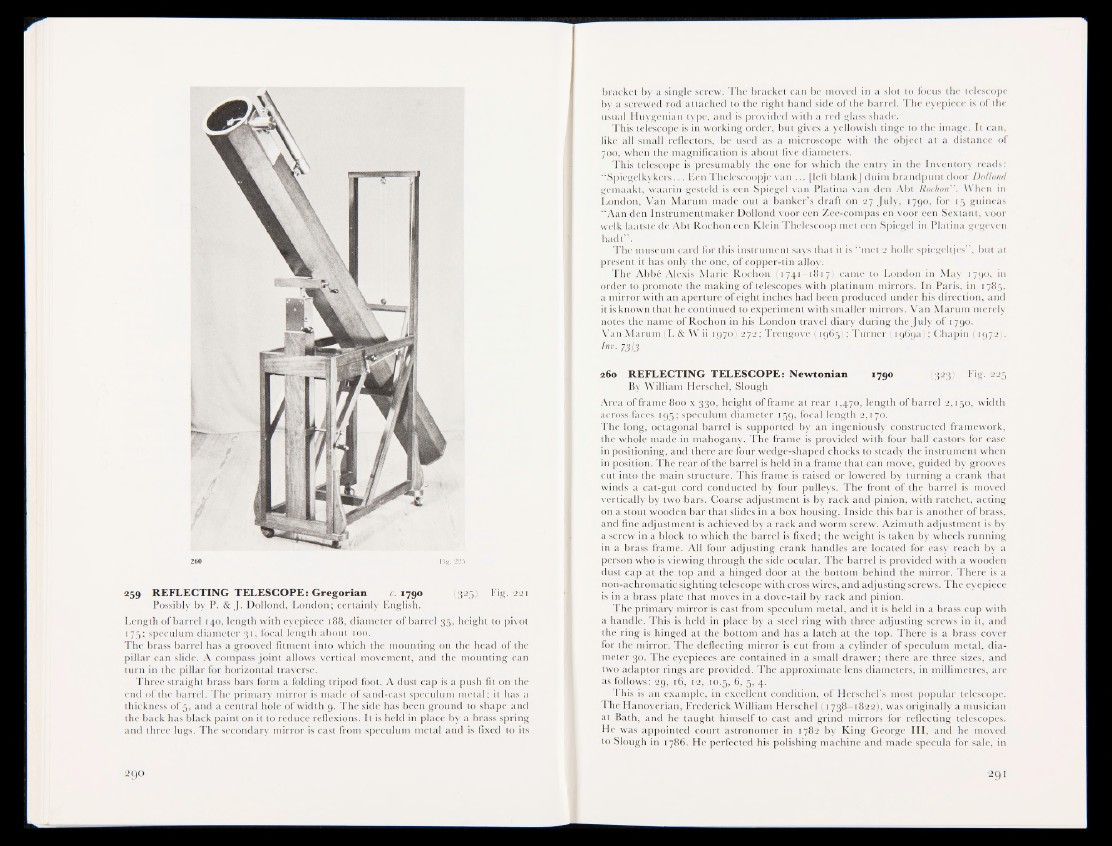
260
259 REFLECTING TELESCOPE: Gregorian c, 1790 fS25) Fig- 221
Possibly by P. & J. Dollond, London; certainly English.
Length of barrel 140, length with eyepiece 188, diameter of barrel 35, height to pivot
175; speculum diameter 31, focal length about 100.
The brass barrel has a grooved fitment into which the mounting on the head of the
pillar can slide. A compass joint allows vertical movement, and the mounting can
turn in the pillar for horizontal traverse.
Three straight brass bars form a folding tripod foot. A dust cap is a push fit on the
end of the barrel. The primary mirror is made of sand-cast speculum metal; it hasa
thickness of 5, and a central hole of width 9. The side has been ground to shape and
the back has black paint on it to reduce reflexions. It is held in place by a brass spring
and three lugs. The secondary mirror is cast from speculum metal and is fixed to its
bracket by a single screw. The bracket can be moved in a slot to focus the telescope
by a screwed rod attached to the right hand side of the barrel. The eyepiece is of the
usual Huygenian type, and is provided with a red glass shade.
This telescope is in working order, but gives a yellowish tinge to the image. It can,
like all small reflectors, be Used as a microscope with the object at a distance of
700, when the magnification is about five diameters.
This telescope is presumably the one for which the entry in the Inventory reads:
“ Spiegelkykers... Een Thelescoopje van ... [left blank] duim brandpunt door Dollond
gemaakt, waarin gesteld is een Spiegel van Platina van den Abt Rochon” . When in
London, Van Marum made out a banker’s draft on 27 July, 1790, for 15 guineas
“Aan den Instrumentmaker Dollond voor een Zee-compas en voor een Sextant, voor
welk laatste de Abt Rochon een Klein Thelescoop met een Spiegel in Platina gegeven
hadt” .
The museum card for this instrument says that it is “met 2 holle spiegeltjes” , but at
present it has only the one, of copper-tin alloy.
The Abbé Alexis Marie Rochon (1741—1817) came to London in May 1790, in
order to promote the making of telescopes with platinum mirrors. In Paris, in 1785,
a mirror with an aperture of eight inches had been produced under his direction, and
it is known that he continued to experiment with smaller mirrors. Van Marum merely
notes the name of Rochon in his London travel diary during the July of 1790.
Van Marum (L & W ii 1970) 272 ; Trengove (1965) ; Turner (ig6ga) ; Chapin (1972).
Inv. 73^
260 REFLECTING TELESCOPE: Newtonian 1790 (323) Fig. 225
By William Herschel, Slough
Area of frame 800 x 330, height of frame at rear 1,470, length of barrel 2,150, width
across faces 195; speculum diameter 159, focal length 2,170.
The long, octagonal barrel is supported by an ingeniously constructed framework,
the whole made in mahogany. The frame is provided with four ball castors for ease
in positioning, and there are four wedge-shaped chocks to steady the instrument when
in position. The rear of the barrel is held in a frame that can move, guided by grooves
cut into the main structure. This frame is raised or lowered by turning a crank that
winds a cat-gut eon! conducted by four pulleys. The front of the barrel is moved
vertically by two bars. Coarse adjustment is by rack and pinion, with ratchet, acting
on a stout wooden bar that slides in a box housing. Inside this bar is another of brass,
and fine adjustment is achieved by a rack and worm screw. Azimuth adjustment is by
a screw in a block to which the barrel is fixed; the weight is taken by wheels running
in a brass frame. All four adjusting crank handles are located for easy reach by a
person who is viewing through the side ocular. The barrel is provided with a wooden
dust cap at the top and a hinged door at the bottom behind the mirror. There is a
non-achromatic sighting telescope with cross wires, and adjusting screws. The eyepiece
is in a brass plate that moves in a dove-tail by rack and pinion.
The primary mirror is cast from speculum metal, and it is held in a brass cup with
a handle. This is held in place by a steel ring with three adjusting screws in it, and
the ring is hinged at the bottom and has a latch at the top. There is a brass cover
for the mirror. The deflecting mirror is eu I from a cylinder of speculum metal, diameter
30. The eyepieces are contained in a small drawer; there are three sizes, and
two adaptor rings are provided. The approximate lens diameters, in millimetres, are
as follows: 29, 16, 12, 10.5, 6, 5, 4.
This is an example, in excellent condition, of Herschel’s most popular telescope.
The Hanoverian, Frederick William Herschel (1738—1822), was originally a musician
at Bath, and he taught himself to cast and grind mirrors for reflecting telescopes.
He was appointed court astronomer in 1782 by King George III, and he moved
to Slough in 1786. He perfected his polishing machine and made specula for sale, in